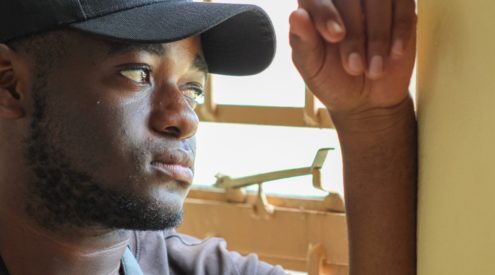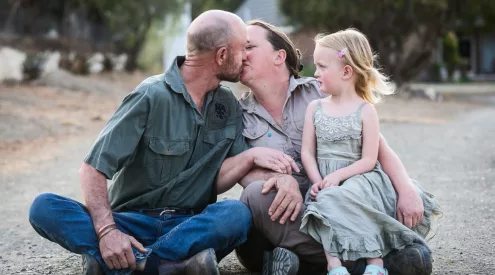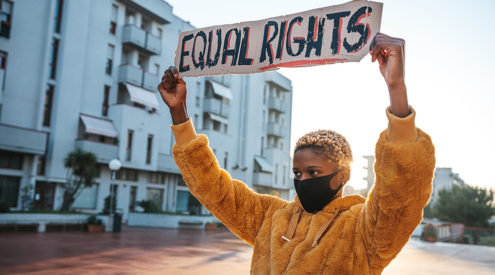Impressions gained through township tourism might contribute to a foundation for more real and significant empathy and respect between South Africans.
The smell of fermentation hangs heavy in the muggy half dark. Flies buzz about, pausing on a knee or toe, only to be swished away by a pale hand. On our arrival, four Xhosa men quickly make room for us. They shuffle into the darkest corners of the dank little shack, where they sit like patients in a doctor’s waiting room: quiet, sullen, tolerant. We haven’t been told their names and after friendly hellos there’s no effort at any interaction.
A big silver tin, which might have held Ricoffy before its makeshift handle was attached, is passed around. The foamy headed umqombothi (traditional beer) is gingerly sipped by nine Germans and me. ‘Ahh, it’s not too bad; a little sweeter than our German beer, but not bad,’ says one. Relief all round. Before leaving, we’re invited to give ‘contributions toward the beer’ – handfuls of coins are emptied into the little receptacle on the sooty dirt floor. Umqombothi tasted, the first box has been ticked on the list of township tourism’s must-dos.

We’re in Langa, one of the oldest black townships in Cape Town, and if I’m honest, I’m not having a great time. It’s all the things I dislike – dirty, a bit depressing and fraught with self-awareness, social discomfort and a sense of deep injustice. It appears a strange phenomenon to me that people are willing to pay hundreds of rand for an experience which offers seemingly little in the way of pleasantness. But pay they do, and flock in their foreign throngs to be shown around this community, one of many that was started on bits of land allocated to blacks during the dark old days.
The initial knee-jerk reaction to this so-called ‘poorism’ is often one of moral disapproval – it is exploitative for people to benefit by making a spectacle of others’ poverty (at R465, the cost of our four-hour tour is considerably more than the weekly income of half the households here). Our tour guide Luvuyo Beja, dressed in his Levi’s T-shirt and Adidas slip-slops, scoffs at this idea. A local resident, he uses the income from guiding to pay for his studies. He hopes to become a teacher. On top of employing many local residents, the company that contracts Luvuyo gives 30 percent of all ticket revenue to a trust responsible for building infrastructure in Langa.
By all accounts, the community participates freely and willingly in the industry, and benefits financially from its existence. No matter how uncomfortable township tourism might seem to some, then, it might be more patronising than anything else to argue against it on the grounds of immoral exploitation.
But this doesn’t mean the industry is without its strangeness. Despite reference to the spirit of ‘ubuntu’ and assurances of how welcome we are, the sense of our own intrusiveness is undeniable. As we enter one of the many apartheid-era migrant workers’ hostels, relics of a despicable system that destroyed families and communities, Luvuyo tells us to look around and talk to the residents. He doesn’t introduce us to anyone, or give any explicit indication that we are expected by the people whose homes we’ve come to observe.
Overcoming my deeply ingrained sense of the sanctity of people’s personal space, I apprehensively knock and step into one of the rooms, where I meet 15-year-old Olwethu. He’s lying on one of three beds with his 10-month old brother. Their whole family’s belongings sit in suitcases stacked like jenga blocks on makeshift shelves above them. Olwethu tells me that three families share this room – 12 people in total.
Looking around from one small single bed to the next, past the microwaves and tangles of phone-charger cables which separate them, it’s unimaginable to me that a dozen people call this space home. According to the 2011 census, the population of Langa’s three square kilometres is 52 000, roughly the same number as you’ll see at Newlands rugby stadium on a sell-out day. That works out at a whopping 17 000 people per square kilometre (compare this to Cape Town CBD’s 2 000). Like Olwethu and his family, many live in the overcrowded, poorly kept hostels.
He doesn’t seem to mind our interaction. But it’s difficult for me from start to finish – from walking into his home as if it is a public attraction, through the realisation of how many live in the tiny room, to taking a photo of him on a camera that cost thousands. The whole experience is surreal.
The German couple I squeeze past on my way out don’t seem as perturbed. They have come to ‘give back to the community’, handing out soccer balls to beaming recipients … but not before taking a staged photo, like some sort of corporate cheque handover. They will leave feeling good, as if they’ve made some sort of contribution, and will head back to Germany, where the lives of Langa locals are a distant memory. The pictures they proudly show their friends will stand testament to their experience of the gritty side of South Africa, exoticised in its incomparability to anything they might see in their first world.
So what about me? I’ve gained a real impression, no matter how superficial, of the conditions under which poor urban South Africans live. An impression left by interactions and experience; an impression incomparable with those left by statistics and stories. It is us comparably wealthy South Africans who could gain the most from township tours, not because of what we leave in the township but what we stand to take away.
This story, by Paul Maughan-Brown first appeared in the May 2014 edition of Getaway Magazine.

















